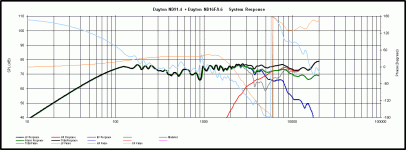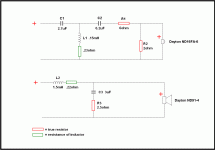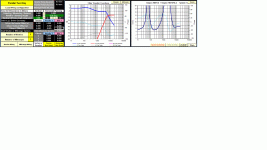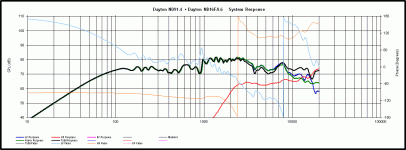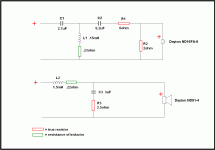What are your front baffle dimensions and driver positions?
I don't have any of the speakers with me currently, they were sent out as gifts and I'm waiting on parts to arrive to rebuild mine, but I believe the tweeter was somewhere around 3/4 - 1" away from the woofer. If anything, it might be even closer. The front baffle is 6.5" x 4.5"
I can do a simulation for you but it occurs to me that as bluetooth speakers, you might just end up placing them on top of a desk (or some sort) and up against a wall. Or are they intended to be on stands, standing freely in space?
The positioning will make a difference in the bass response and therefore a small change in the xo as well.
Have you got these sealed btw?
The positioning will make a difference in the bass response and therefore a small change in the xo as well.
Have you got these sealed btw?
It's usual to wire the tweeter components in the order: resistor, cap, tweeter. That way, any tweaks to the resistor won't affect the crossover frequency i.e. you don't need to include the series resistor when calculating the cap value
Take for example a first order high-pass filter and the applied voltage is from a voltage source. So you have a cap and a tweeter in a series circuit.
Let's say that the impedance of the tweeter at the crossover frequency is Rl = 8 Ohm.
Then the reactance of the cap or Xc at the crossover frequency or Fc also equals 8 Ohm. That way, the tweeter is at -3 dB at Fc, relative to its level well into the passband.
If we want to reduce the level of the tweeter in the passband by -6 dB, we place a resistor Rs = 8 Ohm in-series with the cap and tweeter.
At Fc, for the series connection of Rs, the cap and the tweeter, the total impedance Zt of that series circuit works out to be 18 Ohm. The impedance of the tweeter divided by the total impedance tells us what is the total attenuation of the tweeter's output,
Rl / Zt = 8 Ohm / 18 Ohm = 0.45
20 log 0.45 = -6.9 dB
If the crossover frequency had remained the same, the total attenuation should be -6 dB -3 dB for a total of - 9 dB. Thus you can see that the addition of the 8 Ohm resistor Rs has caused the crossover frequency to change.
In a series circuit, it makes no difference how the components of the series circuit are arranged; regardless of that, voltage division between the components remains the same.
Regards,
cT
If I were to redo my crossovers completely what would you use?
A decent crossover for those drivers probably would take 10 components or more, which is not at all realistic in a tiny box of 1.1 liters. My 3 component crossover from post #15 is not a joke, it's the best solution I found and my recommendation.
Let's wait and see if jReave comes up with a proposal too.
Ok, here are some sims using PCD. For the tweeter, I'm using Zaph's measurements but for the woofer (if you can call a 3.5" driver a woofer?) I've had to rely on Dayton's graphs which actually are usually fairly accurate. I've assumed the driver's are front mounted flush and that the box has no edge treatment. Response is with a sealed alignment.
Let's do the last graph 1st. This is with the component values you currently have but with full baffle step loss incorporated (so the drivers out on stands in free space) and the curves echoe what Dissi showed earlier - basically you are just listening to the ND91-4 with those current filters with barely any contribution from the tweeter at all. Driver phases are nowhere near aligned and the bass should be sounding somewhat thin. I'd probably call this speaker shouty.
The other graphs show the frequency, phase, power and impedance responses plus the transfer functions of the xo I came up with. I tried more than several xo combinations with these drivers but their phases didn't want to line up until I got to 2nd order on the woofer and 3rd order on the tweeter. I ditched the Zobel cause it didn't need it. Part count ends up at 8 with the added resistors - 2 of them for an L-pad on the tweeter. That may seem like a lot but 6 of those parts are caps and resistors which can really be quite small if you choose the right parts, like PE's non polarized caps for example - tiny and inexpensive.
Cross over point is at about 5000Hz. Sensitivity is at about 75dB. The biggest negative here is the suck-out between 300 and 900Hz which is a product of the driver response and baffle diffraction that I unfortunately can't do anything about with the xo, well...... not without maybe doubling the xo parts count!
Let's do the last graph 1st. This is with the component values you currently have but with full baffle step loss incorporated (so the drivers out on stands in free space) and the curves echoe what Dissi showed earlier - basically you are just listening to the ND91-4 with those current filters with barely any contribution from the tweeter at all. Driver phases are nowhere near aligned and the bass should be sounding somewhat thin. I'd probably call this speaker shouty.
The other graphs show the frequency, phase, power and impedance responses plus the transfer functions of the xo I came up with. I tried more than several xo combinations with these drivers but their phases didn't want to line up until I got to 2nd order on the woofer and 3rd order on the tweeter. I ditched the Zobel cause it didn't need it. Part count ends up at 8 with the added resistors - 2 of them for an L-pad on the tweeter. That may seem like a lot but 6 of those parts are caps and resistors which can really be quite small if you choose the right parts, like PE's non polarized caps for example - tiny and inexpensive.
Cross over point is at about 5000Hz. Sensitivity is at about 75dB. The biggest negative here is the suck-out between 300 and 900Hz which is a product of the driver response and baffle diffraction that I unfortunately can't do anything about with the xo, well...... not without maybe doubling the xo parts count!
Attachments
Last edited:
I can do a simulation for you but it occurs to me that as bluetooth speakers, you might just end up placing them on top of a desk (or some sort) and up against a wall. Or are they intended to be on stands, standing freely in space?
The positioning will make a difference in the bass response and therefore a small change in the xo as well.
Have you got these sealed btw?
I have the boxes ported to ~50hz with dual 3/8" diameter tubing. You do hear port noise at louder volumes but at moderate levels it sounds great. They will be used by both me and my wife, mostly in one spot. I'm picky about sound, she isn't quite as much.
Ok, here are some sims using PCD. For the tweeter, I'm using Zaph's measurements but for the woofer (if you can call a 3.5" driver a woofer?) I've had to rely on Dayton's graphs which actually are usually fairly accurate. I've assumed the driver's are front mounted flush and that the box has no edge treatment. Response is with a sealed alignment.
Let's do the last graph 1st. This is with the component values you currently have but with full baffle step loss incorporated (so the drivers out on stands in free space) and the curves echoe what Dissi showed earlier - basically you are just listening to the ND91-4 with those current filters with barely any contribution from the tweeter at all. Driver phases are nowhere near aligned and the bass should be sounding somewhat thin. I'd probably call this speaker shouty.
The other graphs show the frequency, phase, power and impedance responses plus the transfer functions of the xo I came up with. I tried more than several xo combinations with these drivers but their phases didn't want to line up until I got to 2nd order on the woofer and 3rd order on the tweeter. I ditched the Zobel cause it didn't need it. Part count ends up at 8 with the added resistors - 2 of them for an L-pad on the tweeter. That may seem like a lot but 6 of those parts are caps and resistors which can really be quite small if you choose the right parts, like PE's non polarized caps for example - tiny and inexpensive.
Cross over point is at about 5000Hz. Sensitivity is at about 75dB. The biggest negative here is the suck-out between 300 and 900Hz which is a product of the driver response and baffle diffraction that I unfortunately can't do anything about with the xo, well...... not without maybe doubling the xo parts count!
This is outstanding, thank you. If these boxes ever show up, I'll use this crossover design unless anyone has any objections. You mention an lpad but I don't see it in the schematic, how would I wire it in? Also, I really value the bass that I can get out of these tiny speakers, what do you think of my ported design mentioned one post up, I'm I losing a lot of sound quality by not using a sealed design? Their primary location and probably anytime they are moved, they will be within a foot of a wall.
Last edited:
You mention an lpad but I don't see it in the schematic
R1 and R2 form the L-pad.
A decent crossover for those drivers probably would take 10 components or more, which is not at all realistic in a tiny box of 1.1 liters. My 3 component crossover from post #15 is not a joke, it's the best solution I found and my recommendation.
Let's wait and see if jReave comes up with a proposal too.
I took another look at your design, and I am really intrigued by the simplicity of it, which is also kind of my goal; simple but great sounding speakers. Does anyone know how much of a difference I would hear between these two designs?
I really value the bass that I can get out of these tiny speakers, what do you think of my ported design mentioned one post up, I'm I losing a lot of sound quality by not using a sealed design? Their primary location and probably anytime they are moved, they will be within a foot of a wall.
These are nice little drivers - I happen to have 6 of the ND91-8's which are waiting for me to do something with them. Their strength is definitely what they are able to do in the bass department in such small boxes, so ported is fine but your alignment is not the 1st one I would choose. A tuning of 50Hz for that size box means that the LF's start to drop off too early so F3 ends up being about 90Hz. The optimally flat tuning for that size box (and I hope you mean .04 cft net volume) is 66Hz for an F3 of 66Hz.
I appreciate that you're not trying to get mega SPL's out of these things but your port size seems somewhat restrictive as well. But larger diameter ports means longer ones too for the same tuning and then that means you'll need a little larger box for the same net volume also. So you have to weigh that against your own priorities.
Personally, I've got 2 of the 91-8's in test boxes right now that are 5.5L and tuned to 40Hz. The alignment isn't flat but I've got my receiver's AudyseyEQ fixing things up and giving me a decent response with output down to the 40Hz region. I've just got them hooked up to my bedroom's TV for now with no need either for high SPL's. But I agree they need a little help in the high frequencies. Actually my thoughts on these are to pair them with a little 2" or 2 1/2" quality full range driver instead of a tweeter and cross them over down lower around 500 or 600Hz, something like the little Vifa or Peerless or Fountek maybe but I haven't got there yet. For what you are trying to do, I would probably go for a larger box if you are able (like about 2 - 2.5L) and tune it to about 60Hz with just a little bit of peaking right there at 60Hz which tends to give the impression of a deeper bass response.
As regards comparing Dissi's xo with mine, I'm afraid I can't help you there - I've never worked with series xo's yet so can't give you any meaningful advice.
R1 and R2 form the L-pad.
Oh I see, they are like my 50 ohm resistor in my posted setup. I confused them with the variable lpads I've seen on parts express.
The boxes finally made it in. After putting them together, I had some issues at first, getting the right channel to work (still have no idea what it was), and also some serious sound quality issues with the bluetooth receiver. After getting everything sorted out, I'm seriously impressed with these. The clarity and transparency, and the crispness and smoothness of the high's have me more than satisfied. Thanks for the help everyone... I'm so impressed with the sound, I'm thinking I will need to sell our basement tower speakers and build some myself.
What xo did you end up using?
I used your crossover design and ported the boxes to somewhere between 55 and 65hz. I say somewhere between because I have no idea how much volume all the parts going inside takes up. The crossover definitely resolved the overly high highs I was working with before.
Excellent. I wasn't sure what you had gone with. Pretty amazing bass output for such a tiny speaker isn't it? Your friends will be asking you, "No, seriously - where's the subwoofer?"
And for another set of speakers, you can go with even better quality drivers. Lots and lots of proven designs out there to choose from.
Cheers
And for another set of speakers, you can go with even better quality drivers. Lots and lots of proven designs out there to choose from.
Cheers
ive got a pair of nd91s and was considering adding a tweeter. the woofer inductor that has been posted twice was 0.15MH however the last crossover list that got used had a 1.5mh. theres a big difference in size and price so I don't want to order the wrong one. can anyone type out the correct list? and is 20AWG wire size correct?
Make sure you have the 4ohm version of the driver - that is what the xo was designed for. Your baffle needs to be about the same size too - 6.5" x 4.5" with 1/4" between drivers, flush mounted. You can alter the depth and the port(s) to suit your own preferences.
1.5mH is the correct value to use with the rest of the xo re-posted below. Find a gauge that has about the same resistance, .22ohm .
1.5mH is the correct value to use with the rest of the xo re-posted below. Find a gauge that has about the same resistance, .22ohm .
Attachments
ok no worries. thanks reaves. were you aiming for a certain frequency to get down to or can I just go for the recommended volume and port tuning?
ive seen recommendations for 0.1ft with a port of 1inch 4inch long
im aussie so I have to convert everything because the americans like to use barley corns to measure things
btw 8611. are you going to share pics and your impressions of the result?
ive seen recommendations for 0.1ft with a port of 1inch 4inch long
im aussie so I have to convert everything because the americans like to use barley corns to measure things
btw 8611. are you going to share pics and your impressions of the result?
- Status
- This old topic is closed. If you want to reopen this topic, contact a moderator using the "Report Post" button.
- Home
- Loudspeakers
- Multi-Way
- First speaker build 2 way micro bookshelves - need crossover help
